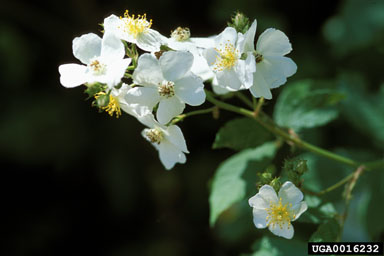Sign up for the iWire to get breaking news, event info and the species spotlight.
Go Back | Printer Friendly Fact Sheet
NOTE:
Rosa multiflora
Multiflora rose
Synonym(s): Rosa cathayensis
Family: Rosaceae (Rose Family)
Duration and Habit: Perennial Shrub

Photographer: James H. Miller
Source: USDA Forest Service, Bugwood.org
Description
Erect climbing, arching, or trailing shrubs to 10 feet (3 m) in height or length. Clump forming. Pinnately compound leaves, frequent recurved and straight thorns, clustered or single white flowers in early summer, and red rose hips in fall to winter.
Native Lookalikes: Currently no information available here yet, or there are no native Texas species that could be confused with Multiflora rose.
Ecological Threat: Multiflora rose is extremely prolific and can form impenetrable thickets that exclude native plant species. This exotic rose readily invades open woodlands, forest edges, successional fields, savannas and prairies that have been subjected to land disturbance.
Biology & Spread: Multiflora rose reproduces by seed and by forming new plants that root from the tips of arching canes that contact the ground. Fruits are readily sought after by birds which are the primary dispersers of its seed. It has been estimated that an average multiflora rose plant may produce a million seeds per year, which may remain viable in the soil for up to twenty years. Germination of multiflora rose seeds is enhanced by passing through the digestive tract of birds.
History: Introduced from Asia in 1866 as a rootstock for grafting ornamental roses. Traditionally planted as ornamentals, livestock containment, and wildlife habitat. Multiflora widely planted for ?living fences? or screening. Later promoted for erosion control and wildlife cover.
U.S. Habitat: Form small-to-large infestations often climbing up into trees. Widely planted and often spreading along right-of-ways and invading new forests and forest margins. Colonize by prolific sprouting and stems that root, and spread by animal-dispersed seeds.
Distribution
U.S. Nativity: Introduced to U.S.
Native Origin: Japan, Korea (Alfred Rehder, Manual of Cultivated Trees and Shrubs: Hardy in North America, The MacMillan Co., New York (1967)); NatureServe Explorer
U.S. Present: AL, AR, CT, DE, FL, GA, IA, IL, IN, KS, KY, LA, MA, MD, ME, MI, MN, MO, MS, NC, NE, NH, NJ, NY, OH, OK, OR, PA, RI, SC, TN, TX, VA, VT, WA, WI, WV
Distribution in Texas: Reported throughout central, eastern and northern Texas.
Mapping
Invaders of Texas Map: Rosa multiflora
EDDMapS: Rosa multiflora
USDA Plants Texas County Map: Rosa multiflora
Invaders of Texas Observations
List All Observations of Rosa multiflora reported by Citizen Scientists
Native Alternatives
Using native shrubs and trees for land restoration and landscaping purposes is one way to prevent invasions by multiflora rose. Texas alternatives include Purple poppy mallow (Callirhoe involucrata), Scarlet mallow (Hibiscus laevis), and Rose mallow (Hibiscus moscheutos). Other alternatives include common blackberry (Rubus allegheniensis), swamp rose (Rosa palustris), flowering raspberry (Rubus odoratus), pasture rose (Rosa carolina).
Management
Mechanical and chemical methods are currently the most widely used methods for managing multiflora rose. Frequent, repeated cutting or mowing at the rate of three to six times per growing season, for two to four years, has been shown to be effective in achieving high mortality of multiflora rose. In high quality natural communities, cutting of individual plants is preferred to site mowing to minimize habitat disturbance. Various herbicides have been used successfully in controlling multiflora rose but, because of the long-lived stores of seed in the soil, follow-up treatments are likely to be necessary. Application of systemic herbicides (e.g., glyphosate) to freshly cut stumps or to regrowth may be the most effective methods, especially if conducted late in the growing season. Plant growth regulators have been used to control the spread of multiflora rose by preventing fruit set.
USE PESTICIDES WISELY: ALWAYS READ THE ENTIRE PESTICIDE LABEL CAREFULLY, FOLLOW ALL MIXING AND APPLICATION INSTRUCTIONS AND WEAR ALL RECOMMENDED PERSONAL PROTECTIVE GEAR AND CLOTHING. CONTACT YOUR STATE DEPARTMENT OF AGRICULTURE FOR ANY ADDITIONAL PESTICIDE USE REQUIREMENTS, RESTRICTIONS OR RECOMMENDATIONS. MENTION OF PESTICIDE PRODUCTS ON THIS WEB SITE DOES NOT CONSTITUTE ENDORSEMENT OF ANY MATERIAL.Text References
Albaugh, G.P., W.H. Mitchell, and J.C. Graham. 1977. Evaluation of glyphosate for multiflora rose control. Proceedings of the New England Weed Science Society, vol. 31, pp. 283-291.
Amrine, J.W., Jr. and T.A. Stasny. 1993. Biological control of multiflora rose. Pp. 9-21. In McKnight, B.N.(ed.). Biological Pollution. Indiana Acad. Sci., Indianapolis. 261 pp.
Evans, J.E. 1983. A literature review of management practices for multiflora rose (Rosa multiflora). Natural Areas Journal 3(1):6-15.
Fawcett, R.S. 1980. Today's weed--multiflora rose. Weeds Today 11: 22-23.
Szafone, R. 1991. Vegetation Management Guidelines: Multiflora rose (Rosa multiflora Thunb.). Natural Areas Journal 11(4):215-216.
The Nature Conservancy. Multiflora Rose: Element Stewardship Abstract. In: Wildland Weeds Management & Research Program, Weeds on the Web.
Wyman, D. 1949. Shrubs and vines for American gardens. New York: MacMillan Co., 613 pp.
Online Resources
APWG WeedUS Database
Miller, J.H. 2003. Nonnative invasive plants of southern forests: a field guide for identification and control. Gen. Tech. Rep. SRS-62. Asheville, NC: U.S. Department of Agriculture, Forest Service, Southern Research Station. 93 pp (USDA SRS).
The Quiet Invasion: A Guide to Invasive Plants of the Galveston Bay Area (www.galvbayinvasives.org). Lisa Gonzalez and Jeff DallaRosa. Houston Advanced Research Center, 2006.
Swearingen, J., K. Reshetiloff, B. Slattery, and S. Zwicker. 2002. Plant Invaders of Mid-Atlantic Natural Areas. National Park Service and U.S. Fish & Wildlife Service, 82 pp.
Search Online
Google Search: Rosa multiflora
Google Images: Rosa multiflora
NatureServe Explorer: Rosa multiflora
USDA Plants: Rosa multiflora
Invasive Plant Atlas of the United States: Rosa multiflora
Bugwood Network Images: Rosa multiflora











